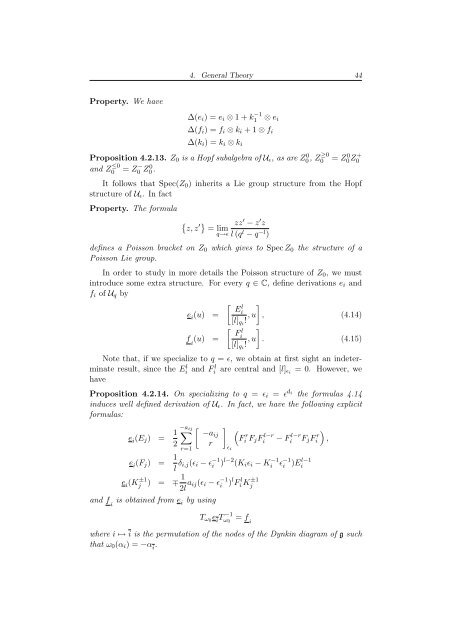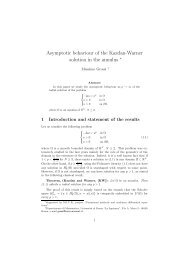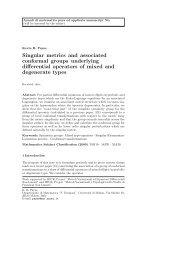Degree of Parabolic Quantum Groups - Dipartimento di Matematica ...
Degree of Parabolic Quantum Groups - Dipartimento di Matematica ...
Degree of Parabolic Quantum Groups - Dipartimento di Matematica ...
You also want an ePaper? Increase the reach of your titles
YUMPU automatically turns print PDFs into web optimized ePapers that Google loves.
Property. We have<br />
4. General Theory 44<br />
∆(ei) = ei ⊗ 1 + k −1<br />
1<br />
⊗ ei<br />
∆(fi) = fi ⊗ ki + 1 ⊗ fi<br />
∆(ki) = ki ⊗ ki<br />
Proposition 4.2.13. Z0 is a Hopf subalgebra <strong>of</strong> Uǫ, as are Z 0 0<br />
and Z ≤0<br />
0 = Z− 0 Z0 0 .<br />
, Z≥0<br />
0 = Z0 0 Z+ 0<br />
It follows that Spec(Z0) inherits a Lie group structure from the Hopf<br />
structure <strong>of</strong> Uǫ. In fact<br />
Property. The formula<br />
z, z ′ = lim<br />
q→ǫ<br />
zz ′ − z ′ z<br />
l (q l − q −l )<br />
defines a Poisson bracket on Z0 which gives to Spec Z0 the structure <strong>of</strong> a<br />
Poisson Lie group.<br />
In order to study in more details the Poisson structure <strong>of</strong> Z0, we must<br />
introduce some extra structure. For every q ∈ C, define derivations ei and<br />
fi <strong>of</strong> Uq by<br />
e i(u) =<br />
f i (u) =<br />
E l i<br />
F l<br />
i<br />
<br />
u<br />
!,<br />
, (4.14)<br />
[l]qi<br />
<br />
u<br />
[l]qi !,<br />
. (4.15)<br />
Note that, if we specialize to q = ǫ, we obtain at first sight an indeterminate<br />
result, since the El i and F l<br />
i are central and [l]ǫi = 0. However, we<br />
have<br />
Proposition 4.2.14. On specializing to q = ǫi = ǫ <strong>di</strong> the formulas 4.14<br />
induces well defined derivation <strong>of</strong> Uǫ. In fact, we have the following explicit<br />
formulas:<br />
ei(Ej) = 1<br />
−aij <br />
<br />
−aij<br />
2 r<br />
r=1<br />
<br />
ǫi<br />
<br />
F r<br />
i FjF l−r<br />
i<br />
− F l−r<br />
i<br />
ei(Fj) = 1<br />
l δi,j(ǫi − ǫ −1<br />
i )l−2 (Kiǫi − K −1<br />
i ǫ −1<br />
i )El−1<br />
i<br />
ei(K ±1<br />
j ) = ∓ 1<br />
2l aij(ǫi − ǫ −1<br />
i )lF l<br />
iK ±1<br />
j<br />
and f is obtained from e<br />
i i by using<br />
Tω0e −1<br />
iTω0 = f i<br />
<br />
r<br />
FjFi ,<br />
where i ↦→ i is the permutation <strong>of</strong> the nodes <strong>of</strong> the Dynkin <strong>di</strong>agram <strong>of</strong> g such<br />
that ω0(αi) = −α i .








